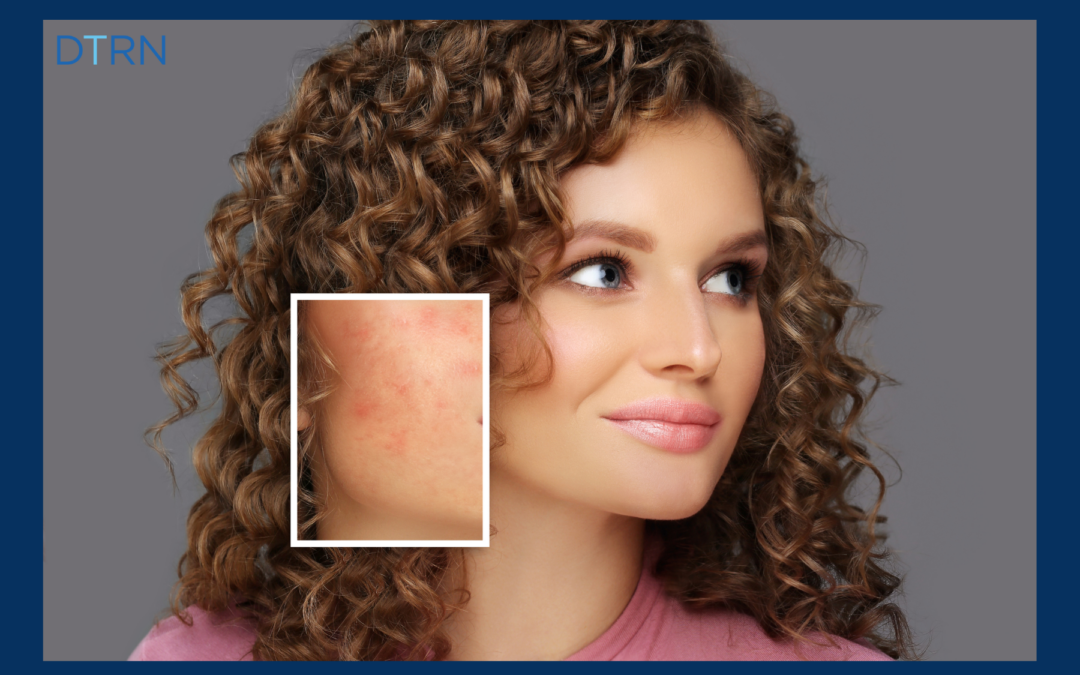If you or someone you know is struggling with acne or acne scarring, here are some of the best acne treatments available to support them in reducing acne and acne scarring and post inflammatory hyperpigmentation…
Acne. Most of us have the experience of a pimple or more at some point in our lives.
Acne can show up in children, teenagers, and adults. It can go away on its own, or it can hang around for months and years if untreated. Ongoing or severe acne can cause permanent acne scarring. The scars occur as part of the skin’s natural healing process.
For anyone that experiences acne and acne scarring, it can be frustrating to figure out how to best treat it and eliminate it when possible. We’ve connected with San Antonio-based DermaTouch RN Aesthetician Amanda McMillan to get her input on the best treatments and products for optimal results when treating acne.
First, to help you better understand why that pesky acne might have surfaced, let’s get some of the foundational information about acne–what causes it and types–out of the way before we dive into treatment options.
What causes acne and acne marks or scars?
Hormonal changes and substances on the skin’s oil glands, skin’s hair follicles, and sebaceous glands can result in acne disorder. The anaerobic bacterium Propionibacterium acnes (P. acnes) are the primary cause of acne.
When Acne takes form as an inflamed cyst, pustule, or papule, inflammation can occur when the pore becomes filled with dead skin cells, bacteria, or excess oil, bacteria. If the pore is engorged, or swells, a break in the follicle, or pore wall occurs (another name for a clogged pore, or hair follicle, is comedo). If the break occurs close to the surface of the skin, then the lesion is likely to heal quickly without scarring.
However, if the follicle, or pore, wall break is deep, then the infected material might spill out onto the surrounding area of the dermis (ick, we know!), which destroys healthy skin cells and tissue. As part of the body’s natural healing process, the skin forms new fibers of collagen to repair the damaged dermis, and this repair can leave what’s referred to as an acne scar (thanks for doing your job skin, but did you have to leave a mark behind?!).
What are some of the different types of acne scars?
Here are some common type of acne scars:
- Keloid Scarring: A mass of raised tissue can occur when the body produces too much collagen to heal a wound. This type of scarring is referred to as keloid, or hypertrophic, scarring.
- Atrophic Scarring: Atrophic scars, or depressed scars, are more common than the other types of acne scars. Two types of atrophic scars are boxcar or ice pick scars.
- Post Inflammatory Hyperpigmentation (PIH): PIH is often referred to as acne scarring, though it’s actually a temporary discoloration of the skin that will eventually fade.
Best acne treatments: How can acne and acne scarring be treated?
Now, for the best part–how can you reduce acne and acne scarring to boost your skin texture, tone, and confidence?
The best acne treatments and treatment protocol recommended will depend on the individual, the severity of scars, and desired results. McMillan shares that there are several in-clinic acne laser treatments and microneedling treatments that can help reduce acne and acne scarring, including:
- Broadband Light Laser (BBL) Clear
- Profractional Laser
- Vivace Radiofrequency Microneedling
- Chemical Peels
“BBL clear is fantastic at killing P. acne bacteria, reducing inflammation caused by acne, and reversing some PIH,” shares McMillan, “and when it comes to resurfacing for severe acne scarring, the Profractional Laser is commonly referred to as the gold standard. Another acne treatment option is Vivace microneedling with radiofrequency, which is quite good at remodeling the texture of the skin. Plus, the treatment’s blue light may be used to help prevent new acne from forming.”
BBL Clear uses light technology to penetrate the skin and improve the appearance of acne, as well as fine lines and wrinkles, skin tone, skin laxity, and more. Recovery time is minimal following a BBL treatment.
Vivace microneedling with radiofrequency helps to stimulate collagen production, which in turn improves the appearance of the skin. The radiofrequency blue light and red light therapy is what differentiates Vivace from other microneedling treatments on the market. The red light provides anti-aging therapy to improve skin texture, tone, and acne scarring. The blue light offers antibacterial therapy that can target active acne and kill bacteria.
The Profractional Laser is a deep laser resurfacing treatment that uses light therapy to penetrate deep into the skin. A treatment can help tighten and refresh the skin, which addresses pitted acne scars, as well as lines, wrinkles, and photo damage or sun damage. There is generally a few days of downtime following a Profractional Laser treatment.
If you have PIH, McMillan suggests chemical peeling as the likely best option. Chemical Peels come in three different levels: light, medium, and deep. Research in the Journal of the American Academy of Dermatology shows that each peel level can be a viable treatment for acne. Mild to moderate acne has been shown to respond to superficial peels, which are generally safe for even darker skin types and reduce comedone, pustule, and papule count. A skincare and acne treatment consultation will help a practitioner determine the best options for your skin when it comes to chemical peels and any other best acne treatment options, as well.
Note: A series of treatments are often recommended for most in-clinic laser and microneedling options to achieve optimal results and benefits. Individual results vary based on individual body chemistry, type of acne, level of acne scarring and discoloration, and amount of acne, among other variables.
What are some of the best topical acne treatment options?
Of course, once you’ve received your in-clinic treatment, you want to continue the trend of acne treatment and prevention at home. Or, maybe a topical solution is the best option based on your unique needs and circumstances. Regardless, it’s best to go with medical grade options when possible, as most practitioners recommend, for some of the best acne treatment options.
SkinMedica is known for their advanced line of medical-grade skincare products, including several products that are ideal for acne prone skin and acne treatment.
McMillan shares, “I like AHA/BHA Cleanser, Retinol, Ultra Sheer Moisturizer, and Everyday Clear Essential Defense Sunscreen for my acne patients.”
McMillan points out that every skin type is different, so your treatment plan should be customized to your individual’s needs.
Best Acne Treatments: Skincare Options for Acne Prone Skin
AHA/BHA Cleanser
The AHA/BHA Cleanser gently exfoliates the skin, scrubbing away dead skin to improve skin tone and texture.
Retinol
Retinol products help to increase the skin’s cellular turnover, improving the skin’s overall appearance.
Ultra Sheer Moisturizer
SkinMedica’s Ultra Sheer Moisturizer is a lightweight and noncomedogenic formula that can work well for acne-prone skin.
Essential Defense Everyday Clear Sunscreen
Essential Defense Everyday Clear Sunscreen is formulated specifically for acne prone skin. It’s a sheer sunscreen that won’t clog pores and provides the highest level of UVA protection, along with UVB protection.
Other common topical acne treatments often prescribed by medical professionals include retinoids and retinoid-like drugs (e.g., tretinoin, retinoic acids), azelaic acid, salicylic acid, benzoyl peroxide, and Dapsone.
Acne Treatment Results and Managing Expectations
The good news is that it is often possible to treat acne in a way that will reduce acne flare-ups, which in turn reduces breakouts and scarring. It’s also possible to treat acne scarring and post-inflammatory hyperpigmentation to reduce its appearance and improve skin tone and texture. With all that said, even the best acne treatments in the world generally don’t return your skin to its pre-acne version.
As McMillan shares, “I think, as with all aesthetic concerns, one must be educated on reasonable expectations. I often compare acne scarring to crumpling a piece of paper. You can use numerous techniques to smooth the paper back out, but in reality, it won’t ever be perfect again. Much of the damage caused by acne scarring is permanent, and while it may be improved, it won’t ever be the same as it was before the damage occurred. Still, there is hope, and many people experience a boost in confidence with even the slightest reduction in the appearance of acne and acne scarring.”
Amanda McMillan, CCMA
Certified Clinical Medical Assistant, Laser Technician, CoolSculpting Specialist
Amanda has over a decade’s worth of experience in clinical and cosmetic Dermatology where she is constantly learning about new products and procedures using the latest technology to bring to her patients. She is known for her ability to focus and provide personalized attention to patients’ concerns, offering customized treatment plans, including tailored product regimens and in-office treatments. Amanda is also a specialized Laser Technician and CoolSculpting Specialist. Learn more about Amanda and the professionals she works with…
DermaTouch RN offers minimally invasive and non-invasive treatments for men and women in Houston, San Antonio, Spring and Cypress, as well as the surrounding areas of Texas. We are the largest aesthetic practice in the Houston area, and all of our medical spa treatments are performed by a team of nurse practitioners, registered nurses, and aestheticians who receive continuing education to remain abreast of emerging treatments that benefit our patients. We invite you to learn more about our office before your consultation.





